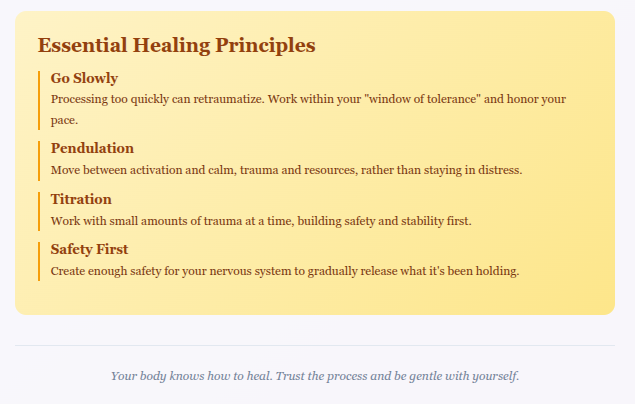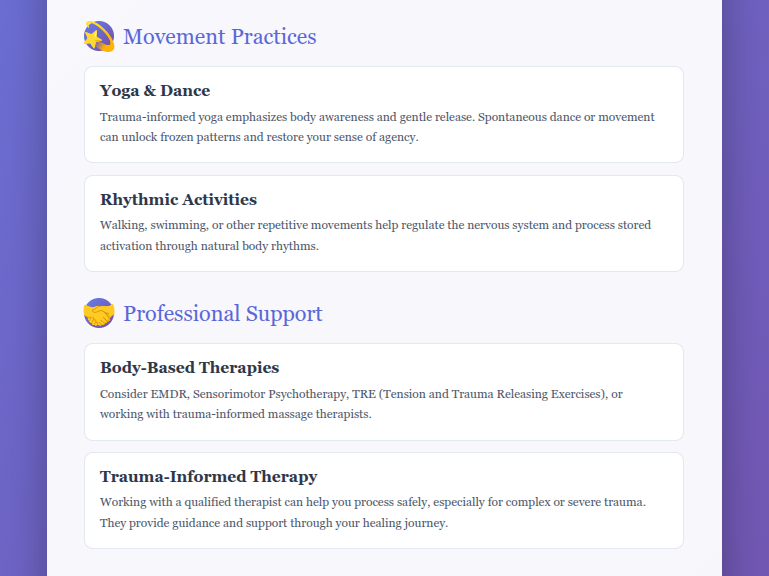Understanding Body-Stored Trauma
When a person experiences trauma, the body and nervous system may remain “stuck” in survival responses such as fight, flight, freeze, fawn, or collapse. The body doesn’t always recognise when the threat has passed, leading to persistent muscle tension, dysregulated breathing, altered posture, chronic pain, or hyper-vigilance. Neuroscience research (e.g., Porges’ Polyvagal Theory) shows that the autonomic nervous system plays a central role — trauma can trap the body in sympathetic arousal (fight/flight) or dorsal vagal shutdown (freeze/collapse). Processing trauma therefore often involves restoring nervous system flexibility and safety.
Disclaimer
The following information provided is for educational and informational purposes only. It is not a substitute for professional medical, psychological, or therapeutic advice, diagnosis, or treatment. Processing trauma and intense emotions can be complex and may bring up distressing feelings or memories. It is strongly recommended that you seek guidance and support from a qualified, trauma-informed mental health professional when exploring or applying these practices.
Effective Approaches for Processing Stored Fear and Trauma
1. Somatic Awareness and Regulation
From Somatic Experiencing (Peter Levine) and other body-oriented therapies
- Notice sensations (tightness, trembling, heat, pressure) without judgment.
- Track activation and settling: notice when your body feels heightened vs. calmer.
- Allow incomplete defensive responses (e.g., pushing, shaking, running motions) to gently complete under safe, guided conditions.
- Gentle shaking or trembling can discharge residual survival energy.
2. Breathwork
- Diaphragmatic breathing calms the vagus nerve and lowers cortisol.
- Longer exhalations (e.g., inhale 4, exhale 6) signal safety to the nervous system.
- Box breathing (4-4-4-4) or 4-7-8 breathing can reduce anxiety and help regulate heart rate variability (HRV).
3. Movement Practices
- Trauma-informed yoga emphasizes interoception (awareness of internal sensations) and choice — essential for rebuilding body trust.
- Dance, rhythmic movement, or martial arts can help release frozen energy and restore agency.
- Walking, swimming, tai chi, or qigong provide grounding, rhythm, and bilateral stimulation.
4. Grounding and Safety Techniques
- 5-4-3-2-1 sensory awareness: notice 5 things you see, 4 you touch, 3 you hear, 2 you smell, 1 you taste.
- Physical grounding: press feet into the floor or hands together to anchor in the present.
- Temperature shifts: splash cold water on your face or hold something cool to help reset the vagus nerve.
- Progressive muscle relaxation: systematically tense and release muscle groups to discharge tension.
5. Body-Based and Integrative Therapies
- EMDR (Eye Movement Desensitization and Reprocessing): integrates traumatic memories while maintaining nervous system regulation.
- Sensorimotor Psychotherapy: combines talk therapy with somatic tracking to integrate body and mind.
- TRE (Tension & Trauma Releasing Exercises): uses controlled tremors to release neuromuscular tension.
- Craniosacral therapy or trauma-informed massage: helps restore body awareness and parasympathetic balance (only with trained practitioners).
Core Trauma-Informed Principles
- Safety First: Healing begins with safety, not with re-exposure. Always prioritize a sense of internal and external security.
- Go Slowly: The nervous system can only integrate what it can tolerate; going too fast risks retraumatisation.
- Pendulation: Gently move between sensations of discomfort and sensations of safety or ease to build regulation capacity.
- Titration: Work with small, manageable amounts of traumatic material at a time.
- Empowerment and Choice: Trauma takes away control — healing restores it. Always honor your body’s “yes” and “no.”
- Professional Support: A trauma-informed therapist or somatic practitioner can provide containment, attunement, and safety when processing deep trauma.
Additional Evidence-Based Practices
- Mindfulness and Compassion Practices: Mindful awareness (without judgment) helps integrate sensations and thoughts, while compassion training (e.g., self-soothing touch, loving-kindness meditation) rebuilds safety within.
- Expressive Writing or Art Therapy: Offers symbolic release of emotions and stored memories.
- Safe Social Connection: The vagus nerve responds powerfully to co-regulation — gentle eye contact, shared laughter, or supportive presence from trusted people.
- Sleep, nutrition, and gentle routines: A regulated body supports a regulated mind; simple self-care anchors healing.



